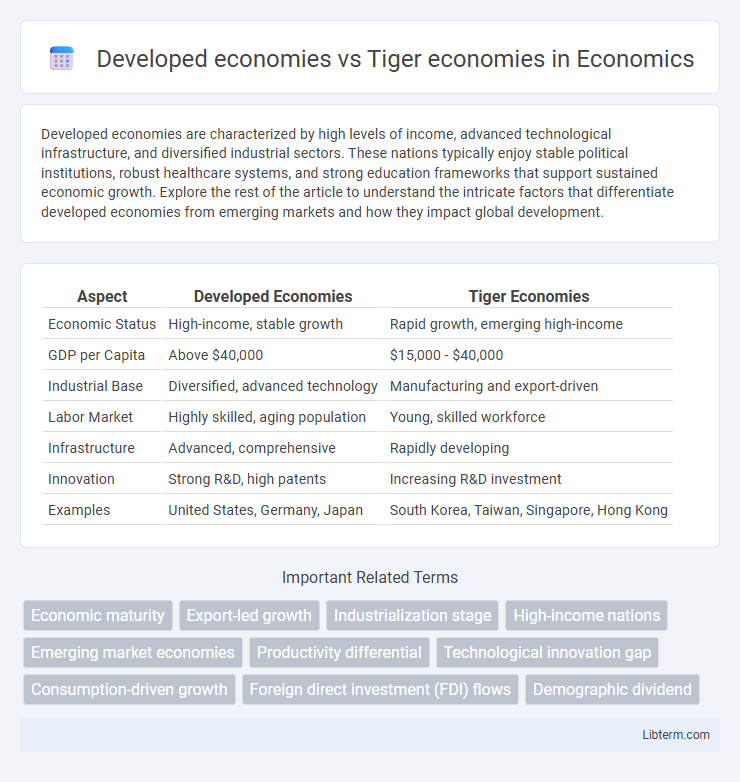Developed economies are characterized by high levels of income, advanced technological infrastructure, and diversified industrial sectors. These nations typically enjoy stable political institutions, robust healthcare systems, and strong education frameworks that support sustained economic growth. Explore the rest of the article to understand the intricate factors that differentiate developed economies from emerging markets and how they impact global development.
Table of Comparison
| Aspect | Developed Economies | Tiger Economies |
|---|---|---|
| Economic Status | High-income, stable growth | Rapid growth, emerging high-income |
| GDP per Capita | Above $40,000 | $15,000 - $40,000 |
| Industrial Base | Diversified, advanced technology | Manufacturing and export-driven |
| Labor Market | Highly skilled, aging population | Young, skilled workforce |
| Infrastructure | Advanced, comprehensive | Rapidly developing |
| Innovation | Strong R&D, high patents | Increasing R&D investment |
| Examples | United States, Germany, Japan | South Korea, Taiwan, Singapore, Hong Kong |
Overview of Developed Economies and Tiger Economies
Developed economies such as the United States, Germany, and Japan are characterized by high GDP per capita, advanced technological infrastructure, and diversified industrial sectors. Tiger economies, including South Korea, Singapore, Taiwan, and Hong Kong, experienced rapid industrialization and economic growth from the 1960s to 1990s, driven by export-oriented policies and significant foreign investment. Both groups exhibit strong global trade integration, but developed economies typically have more mature financial markets and higher standards of living compared to the dynamic yet still evolving economic structures of tiger economies.
Historical Emergence of Tiger Economies
Tiger economies, including South Korea, Taiwan, Hong Kong, and Singapore, emerged rapidly from the 1960s to 1990s due to export-oriented industrialization and strategic government intervention. Developed economies like the United States, Japan, and Western Europe experienced gradual industrial growth over centuries, fueled by technological innovation and capital accumulation. The distinct historical emergence of tiger economies highlights accelerated economic transformation driven by globalization and targeted economic policies.
Key Characteristics of Developed Economies
Developed economies exhibit high gross domestic product (GDP) per capita, advanced technological infrastructure, and well-established financial markets. These economies feature diversified industrial sectors, robust service industries, and strong institutional frameworks supporting innovation and governance. High standards of living, comprehensive healthcare, and extensive social security systems further distinguish developed economies from Tiger economies.
Economic Growth Drivers: Comparison and Contrast
Developed economies rely heavily on advanced technology, diversified industries, and high consumer spending to sustain steady economic growth, while Tiger economies--such as South Korea, Singapore, and Taiwan--achieve rapid growth primarily through export-oriented manufacturing, aggressive investment in industrial infrastructure, and export-led policies. Developed economies benefit from established financial systems and innovation ecosystems that drive productivity, whereas Tiger economies focus on labor-intensive production and capital accumulation with strong government intervention to enhance competitiveness. The contrast lies in the mature service sectors and innovation-driven growth in developed economies compared to the manufacturing-driven, export-focused strategies that catalyze growth in Tiger economies.
Industrialization and Technological Advancement
Developed economies exhibit advanced industrialization characterized by high levels of automation, diversified manufacturing sectors, and extensive infrastructure supporting innovation. Tiger economies, particularly in East Asia, transitioned rapidly from agrarian bases to export-driven industrial hubs through aggressive investment in technology, education, and infrastructure. Both demonstrate significant technological advancements, but tiger economies emphasize rapid adaptation and scaling of manufacturing technologies to boost economic growth and global trade competitiveness.
Trade Policies and Export Strategies
Developed economies typically implement trade policies that emphasize multilateral agreements, regulatory standards, and intellectual property protection to promote stable export growth, with sectors focusing on high-value manufactured goods and services. Tiger economies, such as South Korea, Taiwan, and Singapore, adopt export-oriented strategies driven by aggressive government support, investment in technology, and competitive pricing to rapidly expand market share in electronics, textiles, and machinery sectors. Both models prioritize innovation and global market integration, but Tiger economies emphasize rapid industrialization and export-led growth, while developed economies focus on sustaining diversified trade portfolios and advanced service exports.
Socioeconomic Challenges Faced by Both
Developed economies face socioeconomic challenges such as aging populations, rising healthcare costs, and income inequality, which strain social welfare systems and labor markets. Tiger economies, characterized by rapid industrialization and urbanization, encounter issues like inadequate infrastructure, environmental degradation, and uneven wealth distribution. Both types of economies must address employment disparities and social inclusion to sustain long-term growth and stability.
Labor Markets and Workforce Development
Developed economies typically feature highly regulated labor markets with comprehensive worker protections, extensive social benefits, and advanced workforce development programs that emphasize lifelong learning and skills upgrading. Tiger economies, such as South Korea, Singapore, and Taiwan, have rapidly transformed their labor markets through aggressive investment in education, vocational training, and export-driven industrial policies, resulting in flexible labor practices and high labor productivity. Both economic models prioritize workforce development, but tiger economies focus more on adaptive skill acquisition to support fast-paced industrial growth, while developed economies emphasize stability and innovation in human capital.
Investment Flows and Financial Infrastructure
Developed economies exhibit mature financial infrastructure with robust capital markets, attracting steady and diversified investment flows from global institutional investors. Tiger economies, characterized by rapid industrialization and emerging markets, experience higher volatility in investment flows but benefit from increasing foreign direct investment seeking high growth potential. Financial infrastructure in tiger economies is evolving, often marked by improving regulatory frameworks and expanding banking systems to support accelerated economic development.
Future Prospects and Global Impact
Developed economies such as the United States, Germany, and Japan possess mature infrastructure, advanced technological capabilities, and stable financial systems that enable sustained innovation and global economic influence. Tiger economies, including South Korea, Taiwan, Singapore, and Hong Kong, are rapidly evolving with high growth rates driven by export-oriented industrialization, increasing investments in technology, and expanding middle-class markets. The future prospects indicate that while developed economies will continue to lead in innovation and capital formation, Tiger economies are poised to significantly influence global trade patterns, digital economy transformation, and regional economic integration.
Developed economies Infographic

 libterm.com
libterm.com